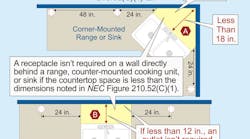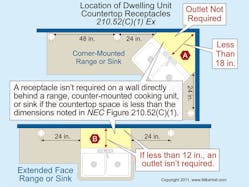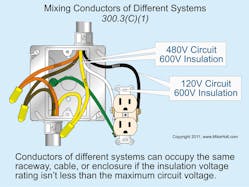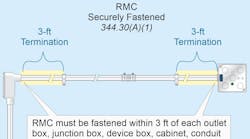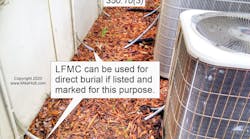All questions and answers are based on the 2011 NEC.
Q. What are the Code rules for using floor receptacles to meet the receptacle wall outlet requirements in a dwelling wall space?
A.Floor receptacle outlets are not counted as the required receptacle wall outlet, if they are located more than
18 in. from the wall [210.52(A)(3)].
Q. What are the NEC rules on placing receptacles for countertops in a dwelling unit kitchen?
A.A receptacle outlet must be installed for each kitchen and dining area countertop wall space 1 ft or wider, and receptacles must be placed so that no point along the countertop wall space is more than 2 ft (measured horizontally) from a receptacle outlet [210.52(C)(1)].
Exception: A receptacle outlet isn’t required on a wall directly behind a range, counter-mounted cooking unit, or sink, in accordance with Fig. 210.52(C)(1) in the NEC, as shown in Fig. 1.
If the countertop space behind a range or sink is larger than the dimensions noted in Figure 210.52(C)(1) of the NEC, then a GFCI-protected receptacle must be installed in that space. This is because, for all practical purposes, if there is sufficient space for an appliance, then an appliance will be placed there.
At least one receptacle outlet must be installed at each island countertop space with a long dimension of 2 ft or more, and a short dimension of 1 ft or more [210.52(C)(2)].
At least one receptacle outlet must be installed at each peninsular countertop with a long dimension of 2 ft or more, and a short dimension of 1 ft or more, measured from the connecting edge [210.52(C)(3)].
The Code does not require more than one receptacle outlet in an island or peninsular countertop space, regardless of the length of the countertop, unless the countertop is broken, as described in 210.52(C)(4).
When breaks occur in countertop spaces for range tops, refrigerators, or sinks, each countertop space is considered as a separate countertop for determining receptacle placement [210.52(C)(4)].
If a range, counter-mounted cooking unit, or sink is installed in an island or peninsular countertop, and the depth of the counter behind the range, counter-mounted cooking unit, or sink is less than 12 in., the countertop space is considered to be two separate countertop spaces.
GFCI protection is required for all 15A and 20A, 125V receptacles that supply kitchen countertop surfaces [210.8(A)(6)].
Receptacle outlets required by 210.52(C)(1) for the countertop space must be located on or above (but not more than 20 in. above) the countertop surface. Receptacle outlet assemblies listed for the application can be installed in countertops [210.52(C)(5)].
Note:Receptacles must not be installed in a face-up position in countertops or similar work surface areas in a dwelling unit [406.5(E)].
Exception: The receptacle outlet for the countertop space can be installed below the countertop only for construction for the physically impaired or when wall space or a backsplash is not available, such as in an island or peninsular counter. Under these conditions, the required receptacle(s) must be located no more than 1 ft below the countertop surface and no more than 6 in. from the countertop edge, measured horizontally.
Receptacle outlets rendered not readily accessible by appliances fastened in place, located in an appliance garage, behind sinks, or rangetops [210.52(C)(1) Ex], or supplying appliances that occupy dedicated space don’t count as the required countertop receptacles.
An “appliance garage” is an enclosed area on the countertop where an appliance can be stored and hidden from view when not in use. If a receptacle is installed inside an appliance garage, then it doesn’t count as a required countertop receptacle outlet.
Q. What is the Code rule for mixing conductors of different systems in the same raceway, cable, or enclosure?
A.Power conductors of alternating-current and direct-current systems rated 600V or less can occupy the same raceway, cable, or enclosure, if all conductors have an insulation voltage rating not less than the maximum circuit voltage [300.3(C)(1)], as shown in Fig 2.
Control, signal, and communications wiring must be separated from power and lighting circuits so the higher-voltage conductors don’t accidentally energize the control, signal, or communications wiring:
• CATV coaxial cable [820.133(A)]
• Class 1 [725.48]
• Class 2 and Class 3 control circuits [725.136(A)]
• Communications circuits [800.133(A)(1)(c)]
• Fire alarm circuits [760.136(A)]
• Instrumentation tray cable [727.5]
• Sound circuits [640.9(C)]
Class 1 circuit conductors can be installed with associated power conductors [725.48(B)(1)], if all conductors have an insulation voltage rating not less than the maximum circuit voltage [300.3(C)(1)].
A Class 2 circuit that’s been reclassified as a Class 1 circuit [725.130(A) Ex 2] can be installed with associated power conductors [725.48(B)(1)], if all conductors have an insulation voltage rating not less than the maximum circuit voltage [300.3(C)(1)].
PV system conductors, both direct current and alternating current, are permitted to be installed in the same raceways, outlet and junction boxes, or similar fittings with each other, but they must be kept entirely independent of all other non-PV system wiring [300.3(C)(1) Note 2 and 690.4(B)].
Q. What are the GFCI protection requirements for a receptacle installed in a non-dwelling location if it is under a counter with a sink above it?
A.All 15A and 20A, 125V receptacles installed within 6 ft of the outside edge of a sink in non-dwelling occupancies must be GFCI protected [210.8(B)(5)].
Exception No. 1: In industrial laboratories, receptacles used to supply equipment where removal of power would introduce a greater hazard aren’t required to be GFCI protected.
Exception No. 2: Receptacles located in patient bed locations of general care or critical care areas of health care facilities are not required to be GFCI-protected.
Q. How does the Code address the spread of fire or products of combustion in regard to fire-rated assemblies?
A.Electrical circuits and equipment must be installed in such a way that the spread of fire or products of combustion won’t be substantially increased. Openings into or through fire-rated walls, floors, and ceilings for electrical equipment must be fire-stopped using methods approved by the authority having jurisdiction (AHJ) to maintain the fire-resistance rating of the fire-rated assembly [300.21].
Fire-stopping materials are listed for the specific types of wiring methods and the construction of the assembly that they penetrate.
Directories of electrical construction materials published by qualified testing laboratories contain listing and installation restrictions necessary to maintain the fire-resistive rating of assemblies. Outlet boxes must have a horizontal separation not less than 24 in. when installed in a fire-rated assembly, unless an outlet box is listed for closer spacing or protected by fire-resistant “putty pads” in accordance with manufacturers’ instructions.
Boxes installed in fire-resistance-rated assemblies must be listed for the purpose. If steel boxes are used, then they must be secured to the framing member, so cut-in-type boxes aren’t permitted (UL White Book,Guide Information for Electrical Equipment, www.ul.com/regulators/2008_WhiteBook.pdf).
This rule also applies to control, signaling, and communications cables or raceways:
• CATV [820.26]
• Communications [800.26]
• Control and signaling [725.25]
• Fire alarm [760.3(A)]
• Optical fiber [770.26]
• Sound systems [640.3(A)]
